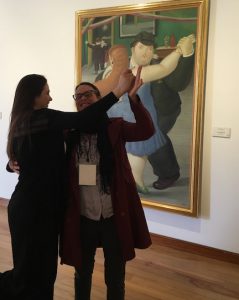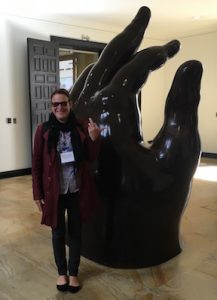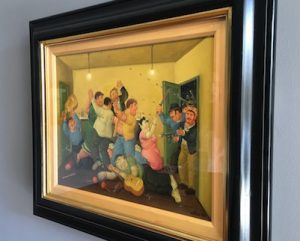Museo Botero, Bogotá, Colombia
My first time in South America included a visit to Museo Botero, a museum founded in 2000 to house a major collection of figurative artist Fernando Botero’s sculptures and paintings. I attended with my new friend Beatriz, a French scholar presenting on the same conference panel with me at the International Federation for Public History, which was meeting at Bogotá at the time.
We were supposed to follow a guided tour, but had waited at the wrong door and mistakenly concluded that the guide had not shown. I was so excited about being in a place with so much from one of my favorite artists that I was less than enthusiastic about waiting in the foyer, and so we decided to show ourselves about.
Botero’s corpulent figures did not disappoint. Large paintings of large beings blared with the joy and humor of living, well, large. We started by posing with our middle fingers aloft next to an oversized sculptured hand in the process of, in the vernacular of my native northern Michigan, making a lone pine (If you cut all but one in a row of pines, the landscape looks like it’s giving you the finger! Get it?! But I digress…)
The paintings kept coming. A family with a rotund, impeccably coiffed poodle, a couple dancing, a woman in a grand green dress pouring a drink while her right eye wandered—all of these inspired laughter and discussion. We posed near a reclining Venus, imitated dancers, and moved in close to photograph the face of a massive cat.
“Massacre on the Best Corner,” a small painting by Botero’s standards, caught our breath and reversed our pattern of laughter. Picturing people murdered in the act of dancing, it showed how quickly the fun can stop. Botero’s life has corresponded with a period of violence borne of the legacies of colonialism and the Cold War, as Colombia struggled with massacres, kidnapping, and rape in the second half of the twentieth century and early years of the 21st century. Citizens have recently achieved a peace between paramilitary groups and the government, brought about in part by the skills of the historians, anthropologists, and community organizers working on transitional justice. It was work we learned about at our conference; community museum exhibits, listening sessions, memory maps, and digital archives attested to the process of recovery and the abilities of those facilitating the activities revolving around justice without revenge. In light of recent increasing violence in my own country, the United States, I took careful note of these public historians’ empathy, care, and professionalism. Historian-healers.
Having learned about the tough job of transitional justice in Colombia, we both paused for some time before “Massacre on the Best Corner.” Like all good museums, Museo Botero encouraged the sharing of both laughter and the cessation of it.
Powered by WPeMatico



